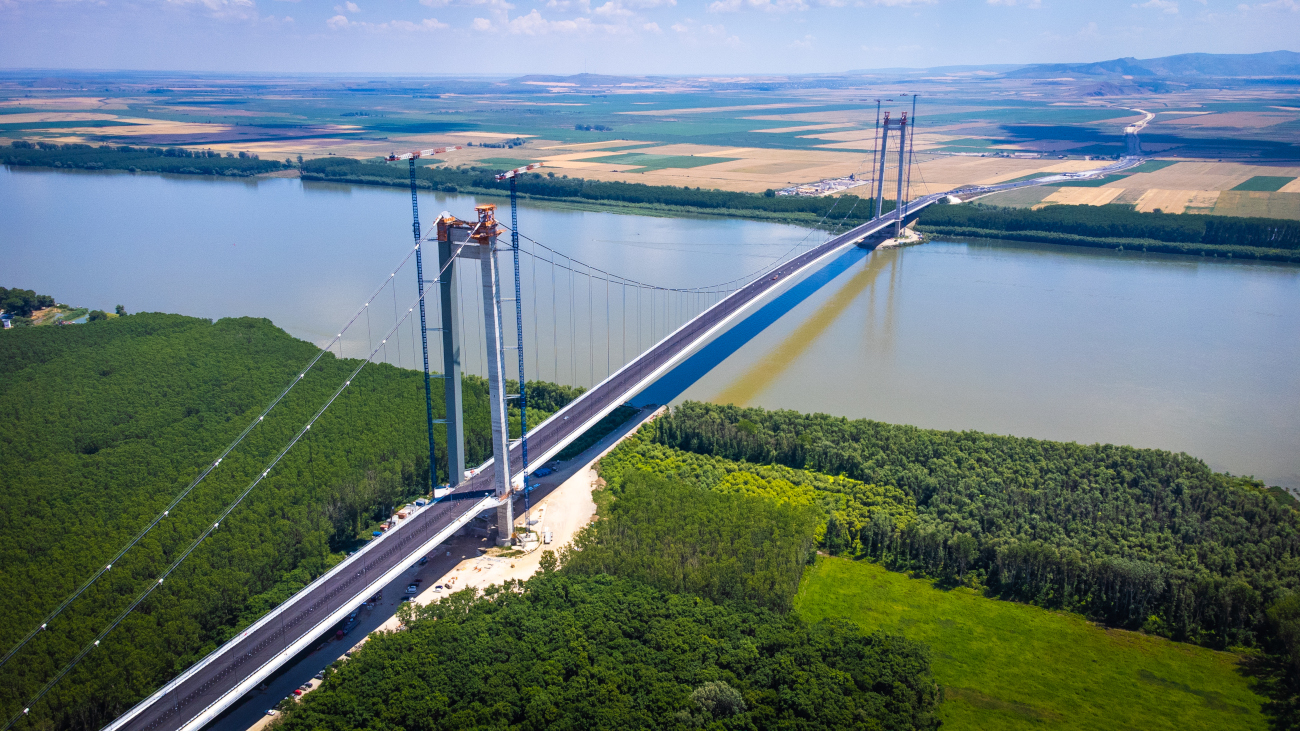Panorama
Brăila Bridge – a great leap for Romania and the EU
- 19 Jul 2023
The new Brăila Bridge over the Danube is an engineering marvel which shows that Romania can carry out complex infrastructure projects. It represents another milestone in the efforts of EU Cohesion Policy to enhance territorial integration and promote economic growth in the EU.
Romanian and EU flags were waved and drivers honked as the first cars crossed the nearly-2 km-long bridge when it was officially opened to the public on 6 July 2023. Dozens of drivers had waited patiently to see Romania’s own version of San Francisco’s Golden Gate Bridge for themselves and claim the honour of being among the first to cross it.
Their enthusiasm is hardly surprising. The bridge will increase economic development and road safety in south-eastern Romania, consolidate the Trans-European Transport Network (TEN-T) and strengthen economic, social and territorial cohesion in the EU.
Links to cohesion policy
European Commissioner for Cohesion and Reforms, Elisa Ferreira, said: ‘This bridge is a statement of how beneficial cohesion policy is for citizens. People no longer need to take the slow and occasionally hazardous ferry trip over the Danube. They can now easily cross the largest river in Europe in minutes, which will have a substantial impact on the region’s economy and on the life of local people and beyond, including the neighbouring Republic of Moldova and Ukraine.’
The largest bridge in Romania and the second-largest suspension bridge in mainland Europe allows drivers to cross the Danube in 2-3 minutes, compared with 50 minutes for the ferry crossing. This brings huge time and money savings for workers and residents in Galați and Brăila travelling east to Tulcea or onwards to the Black Sea coast. Also, goods from Moldova and Ukraine can now reach Bucharest more quickly. An estimated 11 400 vehicles will use the new bridge each day.
Speaking at the inauguration ceremony on 6 July, European Commissioner for Transport, Adina Vălean said the bridge would benefit the Dobrogea and Moldova regions. ‘The bridge has special importance in the current geopolitical context. A larger infrastructure capacity in the Danube area is vital for improving EU security and ensuring the transportation of goods transiting Romania from and to Ukraine and Moldova,’ she said.
President of Romania, Klaus Iohannis was quoted as saying that the bridge was the largest construction project undertaken in Romania in the last 30 years.
‘This construction is certainly one of the most ambitious initiatives to modernise transport infrastructure in Romania, carried out with European funds, with international expertise and with latest generation technology’, he said .
The bridge is an inspiring example of European and international cooperation: Japanese firm, IHI Corporation supplied the cables, and Italian construction firm, Webuild and dozens of Romanian subcontractors worked on the project.
Logistical benefits
Before the bridge was built, crossing the Danube between Brăila and Galați was possible only via several ferry services, including one at the northern and southern end of Brăila that connect the E87 and 212A roads respectively, and a third, near the Galați logistics park that links the 22E road. Outside the ferries’ working hours, the passage could only be made by appointment, or in emergencies.
‘The bridge is the first modern, direct connection between the regions of Moldova and Dobrogea’, said Ionuț Ciurea, executive director of the Pro Infrastructure Association, which represents civil society and aims to ensure that transport infrastructure in Romania is developed in a transparent and responsible manner.
‘Right from the inauguration, we expect a significant impact on transit routes from Moldova to the Back Sea coast and the Danube Delta’, he added .
Stefan Tocu, general manager of a transport company from Galați, said the transport of goods across the Danube by ferry is difficult in winter due to blocks of ice on the river and in summer due to flooding or drought.
Visitors to Romania will also benefit. The Brăila Bridge improves access to the Danube Delta, a UNESCO World Heritage Site and the second-largest river delta in Europe, renowned for its abundant wildlife.
Generous EU support
The EU contributed €363 million to the bridge’s total cost of nearly €500 million. The funding was approved in 2019, following a feasibility study that analysed other options for connecting the two banks of the Danube.
The bridge is part of the EU’s vision, through its cohesion policy, for strengthening the TEN-T and Romanian transport networks and improving transport safety and cross-border connections.
Romania received over €24 billion from the EU’s Cohesion Fund during the 2014-2020 programming period. Of this, €5.6 billion was dedicated to improving transport and energy infrastructure. Corresponding figures for the 2021-2027 period are €31 billion and €4.6 billion respectively.
A global landmark
The distance between the bridge’s two 192 m-high towers is 1 120 m, compared with 1 280 m for the Golden Gate Bridge. Brăila Bridge has a total length of 1 974 m – 4 m longer than its American counterpart – and is 38 m above the water.
There are two lanes in each direction for motorised traffic, an additional two lanes for pedestrians and cyclists, and 23 km of connecting roads.
The 60 cm-thick cables weigh 6 700 tonnes and are made up of 81 000 km of steel wire, enough to circle the Earth twice. Guaranteed to last over a century, they are anchored in cement blocks that are 47 m in diameter and buried at a depth of 31 m.

